Related Research Articles

Fritz Albert Lipmann was a German-American biochemist and a co-discoverer in 1945 of coenzyme A. For this, together with other research on coenzyme A, he was awarded the Nobel Prize in Physiology or Medicine in 1953.

Stanley Rossiter Benedict was an American chemist best known for discovering Benedict's reagent, a solution that detects certain sugars.

The Rockefeller University is a private biomedical research and graduate-only university in New York City, New York. It focuses primarily on the biological and medical sciences and provides doctoral and postdoctoral education. It is classified as a "Special Focus – Research Institution". Rockefeller is the oldest biomedical research institute in the United States.

Roderick MacKinnon is an American biophysicist, neuroscientist, and businessman. He is a professor of molecular neurobiology and biophysics at Rockefeller University who won the Nobel Prize in Chemistry together with Peter Agre in 2003 for his work on the structure and operation of ion channels.

Leonor Michaelis was a German biochemist, physical chemist, and physician, known for his work with Maud Menten on enzyme kinetics in 1913, as well as for work on enzyme inhibition, pH and quinones.
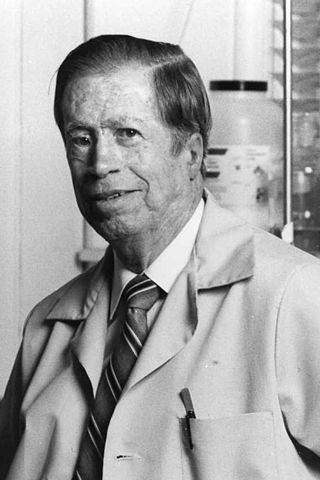
Robert Bruce Merrifield was an American biochemist who won the Nobel Prize in Chemistry in 1984 for the invention of solid phase peptide synthesis.
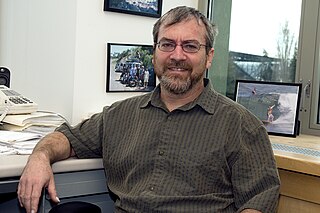
Professor Michael H. Gleb is an American biochemist and chemist specializing in enzymes and particularly those of medical significance. He is the Boris and Barbara L. Weinstein Endowed Chair in Chemistry at the University of Washington in Seattle. He also teaches Honors Organic Chemistry, Chemical Biology and Enzymology.

Elvin Abraham Kabat was an American biomedical scientist and one of the founding fathers of quantitative immunochemistry. Kabat was awarded the Louisa Gross Horwitz Prize from Columbia University in 1977, National Medal of Science in 1991, and American Association of Immunologists Lifetime Achievement Award in 1995. He is the father of Jon Kabat-Zinn.
Max Bergmann was a Jewish-German biochemist. Together with Leonidas Zervas, the discoverer of the group, they were the first to use the carboxybenzyl protecting group for the synthesis of oligopeptides.

John Kuriyan is the dean of basic sciences and a professor of biochemistry at Vanderbilt University School of Medicine. He was formerly the Chancellor's Professor at the University of California, Berkeley in the departments of molecular and cell biology (MCB) and chemistry, a faculty scientist in Berkeley Lab's physical biosciences division, and a Howard Hughes Medical Institute investigator. He is a member of the National Academy of Sciences and he has also been on the Life Sciences jury for the Infosys Prize in 2009, 2019 and 2020.
Charles Tanford was a German-born protein biochemist. He died in York, England, on October 1, 2009.
Joseph Stewart Fruton, born Joseph Fruchtgarten, was a Polish-American biochemist and historian of science. His most significant scientific work involved synthetic peptides and their interactions with proteases; with his wife Sofia Simmonds he also published an influential textbook, General Biochemistry. From 1970 until his death, Fruton worked extensively on the history of science, particularly the history of biochemistry and molecular biology.
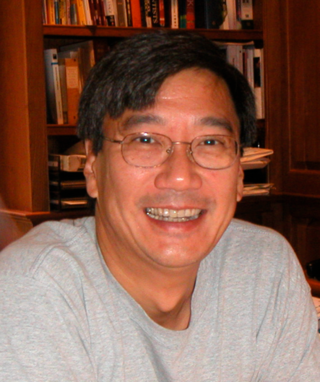
Peter S. Kim is an American scientist. He was president of Merck Research Laboratories (MRL) 2003–2013 and is currently Virginia & D.K. Ludwig Professor of Biochemistry at Stanford University, Institute Scholar at Stanford ChEM-H, and Lead Investigator of the Infectious Disease Initiative at the Chan Zuckerberg Biohub.
Richard Vance Wolfenden NAS AAA&S is an Alumni Distinguished Professor of chemistry, biochemistry and biophysics at the University of North Carolina at Chapel Hill. He was elected to the National Academy of Sciences in 2002. His research involves the kinetics of enzymatic reactions, and his laboratory has made significant contributions to the understanding of catalytic rate enhancements.

Avril Danica Haines is an American lawyer and senior government official who serves as the director of national intelligence in the Biden administration. She is the first woman to serve in this role. Haines previously served as Deputy National Security Advisor and Deputy Director of the Central Intelligence Agency (CIA) in the Obama administration. Prior to her appointment to the CIA, she served as Deputy Counsel to the President for National Security Affairs in the Office of White House Counsel.
Harold Abraham Scheraga was an American biophysicist and the George W. and Grace L. Todd Professor Emeritus in the chemistry department at Cornell University. Scheraga is regarded as a pioneer in protein biophysics and has been especially influential in the study of protein solvation and the hydrophobic effect as it relates to protein folding.
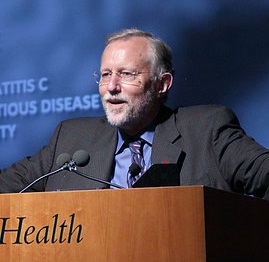
Charles Moen Rice is an American virologist and Nobel Prize laureate whose main area of research is the hepatitis C virus. He is a professor of virology at the Rockefeller University in New York City and an adjunct professor at Cornell University and Washington University School of Medicine. At the time of the award he was a faculty at Rockefeller.
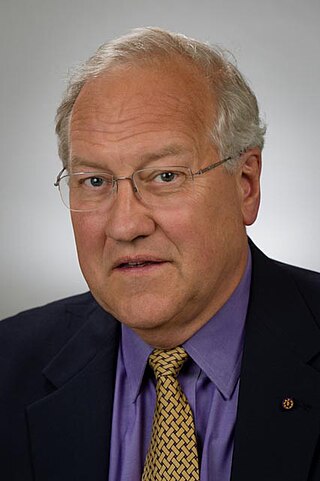
Robert A. Lamb was a British-American virologist. He was the Kenneth F. Burgess Professor at Northwestern University and since 1991, an investigator of the Howard Hughes Medical Institute. From 1990 to 2016, he was the John Evans Professor of Molecular and Cellular Biology at Northwestern University.

Thomas P. Sakmar is an American physician-scientist and the former acting president of The Rockefeller University. Prior to becoming acting president he was associate dean for graduate studies in the Tri-Institutional MD–PhD Program.
Bonnie Ann Wallace, FRSC is a British and American biophysicist and biochemist. She is a professor of molecular biophysics in the department of biological sciences, formerly the department of crystallography, at Birkbeck College, University of London, U.K.
References
- ↑ "The Sakmar Lab: People". The Rockefeller University. Retrieved February 15, 2024.
- ↑ "From the Orphanage to the Lab". The Story Collider. Retrieved 2018-08-23.
- 1 2 3 Haines, Thomas; Lewis, Mindy (6 August 2019). A Curious Life: From Rebel Orphan to Innovative Scientist. New York: Post Hill Press. ISBN 9781642931938.
- ↑ McNew, George L. (April 1962). "Division of Microbiology*: Richard J. Block as Scientist and Individual May 4, 1906-February 4, 1962". Transactions of the New York Academy of Sciences. 24 (6 Series II): 670–674. doi:10.1111/j.2164-0947.1962.tb01903.x. ISSN 0028-7113. PMID 13932238.
- ↑ Ochromonas danica
- ↑ "Authors Thomas H. Haines Archive | Post Hill Press". posthillpress.com. Retrieved 2020-12-01.
- ↑ "American Association for the Advancement of Science". American Association for the Advancement of Science. AAAS. Retrieved 26 January 2021.
- ↑ "ODNI Welcomes Avril Haines as Director of National Intelligence". www.odni.gov. Retrieved 22 January 2021.
- ↑ "Al Pacino was once a terrible super on the Upper West Side, according to his former boss". The New York Post . September 28, 2019.